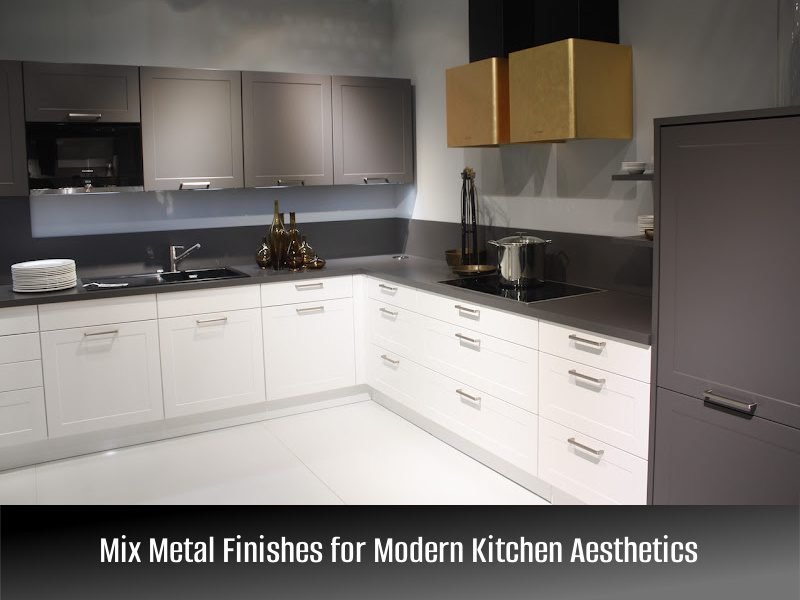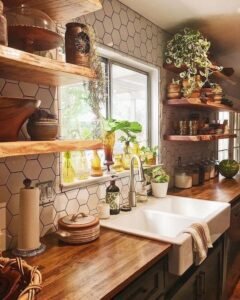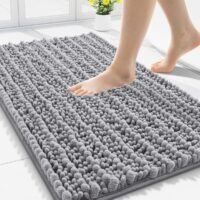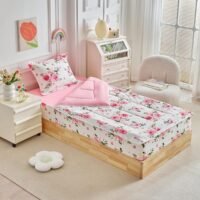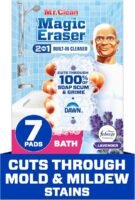Mix metal finishes in your modern kitchen by choosing a dominant metal for fixtures and complementing it with accents. Balance the design by evenly distributing different finishes across the space.
Creating a visually appealing modern kitchen requires more than just selecting the latest appliances; it involves an artful mixing of metal finishes to add depth and character to the space. While stainless steel has long been the go-to choice, incorporating a blend of copper, brass, or matte black can elevate the aesthetic.
It’s essential to strike the right balance: select one metal to lead the design and use others as highlights for cabinet pulls, light fixtures, or faucet details. Spread these contrasting elements throughout the kitchen to establish a cohesive look that reflects a curated, designer feel. This approach to kitchen design not only adds visual interest but also allows for personalization, ensuring your kitchen is both modern and uniquely yours.
Understanding Metal Finish Mixing
The essence of ‘Understanding Metal Finish Mixing’ lies in the art of combining different hues and textures of metals to create a harmoniously modern kitchen. This design principle allows for personal expression and innovation, pushing the boundaries of what’s traditionally expected in kitchen aesthetics. By understanding how to effectively mix metal finishes, the prospect of designing a modern kitchen becomes an exciting journey of discovery and creativity.
The importance of metal finishes in kitchen aesthetics
Importance Of Metal Finishes In Kitchen Aesthetics
Metal finishes play a crucial role in defining the character of a kitchen. They add sparkle and sheen, reflecting light to brighten the space and create a sense of cleanliness. Well-chosen metal elements can be the final touch that brings a design together, providing visual interest and contrasting textures. From cabinet handles and faucet fixtures to lighting and bar stools, metal accents are intrinsic to modern kitchen design.
Different types of metal finishes and their characteristics
Different Types Of Metal Finishes And Their Characteristics
When contemplating metal finishes, it’s important to know each type’s distinctive characteristics:
- Stainless Steel: Known for its durability and resistance to corrosion, stainless steel has a sleek, reflective surface.
- Brass: Offers a warm, golden tone that can range from muted to bright, depending on the finish.
- Copper: Rich in color with a natural warmth, copper can also develop a distinctive patina over time.
- Chrome: Highly reflective with a cool, blue-toned sheen, chrome provides a contemporary look.
- Brushed Nickel: Its satin-like finish offers a muted appearance with less glare.
Each metal finish has its own unique texture and level of shine, which can be used to complement or contrast with other design elements in the kitchen.
The trend of mixing metal finishes in modern kitchens
The Trend Of Mixing Metal Finishes In Modern Kitchens
The modern kitchen is no longer bound by the idea that all fixtures and hardware must match. On the contrary, mixing metal finishes is a trend that embraces diversity and sophistication. This approach adds depth and dimension to the space, allowing designers and homeowners to customize their kitchens to reflect their style and personalities.
For example, pairing the cool tones of stainless steel appliances with the warmth of brass cabinet hardware creates a balanced, inviting space. Likewise, the addition of a copper sink or lighting fixtures can serve as a vibrant focal point amidst more subdued metals.
With this trend, there are no strict rules, encouraging a playful mix that aligns with the overall design concept. Whether it’s achieving a rustic, industrial, or sleek contemporary look, the key is to maintain a cohesive design thread that ties different metal finishes together, making the kitchen feel thoughtfully curated rather than chaotic.
Begin With A Focal Point
Embracing the trend of mixed metal finishes in modern kitchens begins with establishing a clear design anchor. This focal point serves as the foundation upon which the rest of your metallic symphony will harmonize. Let’s delve into how setting this primary metal tone can elevate the aesthetic of your culinary space.
Identifying The Primary Metal Finish
The journey to a cohesive mixed-metal kitchen design starts by selecting one dominant metal finish that resonates with the desired ambiance. This primary metal will lay the groundwork for your kitchen’s overall feel. Consider durability, maintenance, and lifestyle when making this decision. Whether it’s the sleek sophistication of stainless steel, the warm, classic appeal of copper, or the understated elegance of brushed nickel, this primary metal will act as your kitchen’s cornerstone.
How Focal Points Influence Other Design Choices
The focal point in your kitchen, be it a bespoke range hood, a majestic island pendant, or a statement sink, commands attention and inherently guides the arrangement of subsequent design elements. With the primary metal established, secondary metal finishes can be introduced. Approach these accents as complements that bring contrast and depth to the space. Drawer pulls, faucet choices, and light fixture details will all play a supportive role in this design narrative. Ensure these elements are balanced and resonate with the main theme set by the primary finish, fostering a modern, cohesive look without overpowering the senses.
Balancing Warm And Cool Tones
The interplay between warm and cool metal finishes can inject a sophisticated ambience into any modern kitchen. Striking the right balance requires an understanding of each finish’s characteristics and the clever combination of contrasting tones. Done thoughtfully, this can create a kitchen space that feels both inviting and cutting-edge.
Characteristics Of Warm And Cool Metal Finishes
Warm metal finishes, like copper and brass, bring a touch of coziness and rustic charm, radiating a welcoming glow that can soften the overall look of a kitchen. The intrinsic traits of these metals add a rich, organic feel.
Conversely, cool metal finishes—think chrome and stainless steel—provide sleekness and a contemporary vibe. They reflect light in a way that can make a space feel more open and airy. Bringing a minimalist and industrial flair, cool metals are often lauded for their crisp and clean appearance.
Strategies For Combining Warm And Cool Tones
Melding warm and cool tones involves a nuanced approach, such as:
- Selecting a Dominant Tone: Decide whether warm or cool metals will be the primary focus, then use the other as an accent.
- Using Fixtures and Appliances: Pair stainless steel appliances with a copper sink or brass cabinet handles for an elegant contrast.
- Consider proportions: warm finishes can dominate smaller areas for a pop of warmth, while cool metals can be ideal for larger surfaces.
- Layering Textures: Combine different finishes with varying textures to add depth to the visual aesthetic.
Achieving Harmony In Contrast
Contrast does not have to mean conflict. To achieve a harmonious kitchen design, follow these tips:
- Anchor the design with one metal that serves as the main finish for your kitchen.
- Introduce a contrasting metal as an accent—pendant lights, drawer pulls, or a faucet—to complement the primary finish.
- Keep a consistent finish among similar elements (all seating or all lighting fixtures).
- Utilize natural breaks in the space, like the edge of a countertop or cabinetry, to transition between metals.
Incorporating a thoughtful mix of metal finishes can elevate the style quotient of any modern kitchen, making it a showcase of elegance and design prowess.
:max_bytes(150000):strip_icc()/Best-Places-to-Buy-Cabinet-Hardware-FW-tout-bf9bf572099e4055bd0d71606b20176c.jpg)
How To Mix Finishes Cohesively
Integrating various metal finishes into a modern kitchen design not only enhances visual interest but also imparts a bespoke, designer quality to the space. The key to a harmonious blend lies in a thoughtful approach that balances contrast with continuity. When done correctly, mixing metal finishes can produce a layered, sophisticated aesthetic. Let’s explore actionable ways to achieve this cohesive look.
Tips For Selecting Complementary Metal Finishes
Begin with a plan. Select a dominant finish as a starting point to anchor the space and inform subsequent choices. This primary finish often relates to the most abundant features, such as appliances or cabinetry hardware. Introduce a secondary metal that contrasts yet harmonizes with the main finish. Consider the undertones—warm hues pair well with other warm tones, while cool tones complement one another. To aid in selection, keep a color palette handy and aim for a balance, not an overwhelming mix.
- Satin nickel and chrome offer a cool juxtaposition to warmer tones.
- Brass and copper introduce warmth that softens modern lines.
- For a subtle variance, pair brushed and polished versions of the same metal.
Using Repetition To Create A Cohesive Look
Repetition is a powerful design tool. Repeat each finish at least twice to establish a rhythm in the kitchen. This creates a visual thread that leads the eye around the room, promoting unity. Repetition can present itself in the form of light fixtures, faucet finishes, or cabinet hardware. Ideally, spread these elements out to disperse the finishes evenly across the kitchen, preventing any single area from feeling disjointed.
| Metal Finish | Examples of Repetition |
|---|---|
| Brass | Drawer pulls, pendant lights, sink faucet |
| Stainless Steel | Appliances, cabinet handles, and pot filler |
The Role Of Texture In Metal Finish Mixing
Texture plays a pivotal role in the mixing of metal finishes by adding depth and dimension. A high-gloss finish can be the perfect counterpoint to matte surfaces, preventing a flat or monotonous look. By incorporating textured elements like a hammered copper sink or brushed nickel handles, a tactile quality emerges. These variations capture light differently, contributing to the dynamic interplay within the kitchen. Always be mindful to strike a harmonious balance; too many textures can be overpowering, so choose one or two textured finishes to complement smoother surfaces.
- Identify areas for matte, brushed, or hammered finishes that work in concert with polished metals.
- Limit the mix to a reasonable count—often, two to three textures are sufficient.
- Consider the maintenance and practicality of each texture in a kitchen environment.
Accessorizing With Mixed Metals
The trend of mixing metal finishes is transforming modern kitchen aesthetics from monotonous to eclectic. Creating a balance between different metals brings texture, depth, and a personal touch to your kitchen space. Let’s delve into how to curate a harmonious blend of metal finishes through smart accessorizing.
Selecting Hardware And Fixtures With Varied Finishes
Starting with the basics, selecting diverse hardware and fixtures is the foundation for mixing metals in your kitchen. Consider these steps:
- Choose a dominant metal to serve as the main finish in your kitchen, such as stainless steel for appliances.
- Integrate a secondary metal like brass or bronze for your cabinet hardware, providing a striking contrast.
- Ensure that the finishes complement one another, whether through color temperature or texture.
Utilizing Accent Pieces To Tie The Look Together
Accent pieces are the secret ingredients that can seamlessly meld varied metal finishes together. Sprinkle in items like:
- A decorative metal fruit bowl on the countertop.
- Stylish metal-framed chairs surround the kitchen island.
- Elegant pendant lights with a contrasting metal finish hang above the dining area.
These accents should ideally pick up on one or more of the finishes already present to create a cohesive look.
Examples Of Successful Accessory Coordination
Witnessing real-life examples provides inspiration for your metal-mixing venture.
| Metal Finishes | Accessories and Fixtures | Placement in Kitchen |
|---|---|---|
| Brushed Nickel and Copper | Nickel cabinet handles, Copper sink faucet | Cabinetry and Sink Area |
| Matte Black + Gold | Black bar stools, Gold lighting fixtures | Island and Above Dining Space |
| Chrome + Bronze | Chrome pot filler, Bronze decorative tray | Stove Area and Countertop |
Observe how each combination uses one metal as a focal point while the other adds an unexpected pop of character and style.
Elevate With Lighting Choices
A modern kitchen is not just a place for culinary creativity but also a canvas for interior designers and homeowners to express themselves. Mixing metal finishes can bring depth and character to the kitchen space, and the right lighting can elevate this aesthetic to greater heights. In this section, we will focus on how to make smart lighting choices that spotlight the beauty of mixed metal finishes, effortlessly enhancing the modern kitchen atmosphere.
Impact Of Lighting Fixtures On Metal Aesthetics
Lighting fixtures do more than illuminate spaces; they play a pivotal role in how the colors and textures of mixed metals are perceived. Strategic lighting placement can accentuate the reflective qualities of metals, create intriguing shadows, and highlight the subtleties of different finishes. The type of lightbulb and intensity also affect the ambiance, with warmer tones complementing metals like copper and brass and cooler tones enhancing chrome and silver finishes.
Selecting lighting with adjustable brightness can cater to different moods and occasions, allowing the mixed metals in your kitchen to shine or recede as required. Here’s how lighting choices can significantly impact the aesthetic:
- Highlight Key Areas: Aim lights at areas where different metals converge for a dramatic effect.
- Layering: Combine ambient, task, and accent lighting to create depth within the kitchen space.
- Color Temperature: Use bulbs with different color temperatures to bring out the best in each metal finish.
Choosing Lighting That Enhances Mixed Metal Finishes
To create a cohesive and inviting space, the choice of lighting should both complement and draw attention to the mixed metal finishes within your kitchen. Keep the following points in mind:
- Consistency: Choose lighting fixtures with elements that echo your kitchen’s predominant metal finish to maintain a sense of unity throughout the space.
- Contrast: Introduce a bold fixture that stands out while still harmonizing with the existing metal tones.
- Alignment: Align the style of your lighting fixtures with the overall design of your kitchen to ensure a seamless integration.
Think about the statement you want to make. Geometric shapes can provide a contemporary edge, while classic pendants may offer timeless elegance. Metal finishes for light fixtures need not match cabinet hardware or faucets perfectly but should exist within the same design family to produce a thought-out, deliberate look.
Mixing metals and choosing appropriate lighting are art forms that, when mastered, can transform a simple kitchen into a modern masterpiece. Embrace the mixed metal trend and watch your kitchen come to life with just the right light!
Execution In Kitchen Zones
Tackling the ‘Execution in Kitchen Zones’ is a critical step when it comes to mixing metal finishes in a modern kitchen aesthetic. This strategy revolves around carefully planning and distributing different metals in a way that is both visually appealing and functional. Understanding the kitchen layout and defining specific zones helps in creating a cohesive look without compromising on the flow or usability of the space. Now, let’s delve into how these zones can be defined and how to balance mixed metals across them.
Defining Kitchen Zones For Metal Finish Distribution
The first step in successfully mixing metal finishes is to define the different zones within the kitchen. These typically include areas for cooking, washing, food preparation, and storage. Each zone offers opportunities for incorporating various metals in a subtle and organized manner.
- Cooking Zone: This is where stoves and ovens are placed and often features stainless steel or copper finishes.
- Washing Zone: Home to the sink and dishwasher, where chrome or nickel finishes are common.
- Prep Zone: The area used for slicing and dicing may include a mix of metal accents on countertops or utensil holders.
- Storage Zone: Cabinets and pantries can showcase hardware in contrasting metals for added visual interest.
Balancing Mixed Metals Across Different Kitchen Areas
The secret to a beautifully mixed metal kitchen is finding balance and harmony between the different areas. To achieve this, there are simple rules to follow:
- Choose a dominant metal to lead your design, and complement it with one or two accent metals to avoid a cluttered look.
- Ensure the finishes are spread out across the kitchen zones, maintaining a cohesive rhythm between the spaces.
- Distribute shiny and matte finishes to create depth and interest while keeping in mind the overall kitchen lighting.
- Use transitional pieces, like a mixed metal faucet or light fixtures, to tie different areas together seamlessly.
Consistency is key, so consider repeating the same mix of metals in similar proportions throughout the space. This will help create a flow that is easy on the eyes and makes the entire space feel thoughtfully curated.
Frequently Asked Questions On How To Mix Metal Finishes For Modern Kitchen Aesthetics
Can You Mix Different Metal Finishes In A Kitchen?
Absolutely! Mixing metal finishes can add depth and visual interest to your kitchen. It’s about balancing rather than matching, creating a layered and curated look.
What Are Popular Metal Finishes For Modern Kitchens?
Popular metal finishes for modern kitchens include stainless steel, brushed nickel, brass, and matte black. Each offers a distinct style and can be harmoniously combined for a contemporary aesthetic.
How Many Metal Finishes Can You Mix In One Kitchen?
It’s best to limit yourself to two or three metal finishes. This helps maintain a cohesive look, while still adding enough contrast to make the space dynamic and interesting.
What Is The Best Way To Balance Mixed Metal Finishes?
To balance mixed metal finishes, distribute them evenly throughout the space. Use each finish multiple times in various locations to create a sense of harmony and intention.
Conclusion
Embracing mixed metal finishes in your modern kitchen design can truly elevate its elegance. It’s about balance, coordination, and a touch of creativity. Remember to keep a cohesive flow, limit your palette, and consider the room’s overall feel. Start small, trust your instincts, and watch your kitchen come to life with a dynamic, contemporary finesse.

Hi, I’m Esrat, and I’m so glad that you found me here at Happy Food Kitchen! I started Happy Food Kitchen in 2023 to have a creative, right-brained outlet to balance my very left-brained career in genetics.

